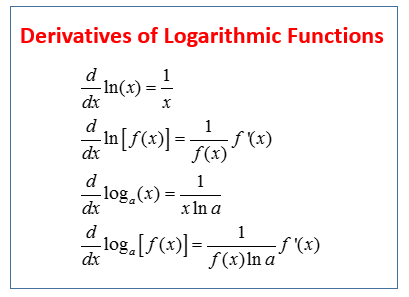
There are cases in which differentiating the logarithm of a given function is simpler as compared to differentiating the function itself. This elementary Demonstration illustrates the fast accuracy of this important formula by plotting both functions side by side for a varying range up to. Logarithmic differentiation is a method to find the derivatives of some complicated functions, using logarithms. Hence the formula becomes for large, which leads straightforwardly to the Boltzmann distribution. This amounts to neglecting next to : for large. The only difficult step in this computation is the left-hand side of this equation. One then has to differentiate the function with respect to, which gives. When the system is in contact with an energy reservoir that keeps the average energy per state constant, one can use a Lagrange multiplier to account for the constraint that is constant. If we differentiate 1/x we get an answer of (-1/x 2).When optimizing the energy repartition in a statistical ensemble by maximizing the total number of states with respect to each state occupation number, it is convenient to take the log of this expression to transform the product into a sum and simplify the differentiation with respect to. So to find the second derivative of ln(3x), we just need to differentiate 1/x To calculate the second derivative of a function, you just differentiate the first derivative.įrom above, we found that the first derivative of ln(3x) = 1/x. Ln3 is a constant, the derivative of a constant is 0
#Derivative of log function how to
How to find the derivative of ln(3x) using the product property of logs f(x) Since 3x is the product of 3 and x, we can use the product properties of logs to rewrite ln(3x): In other words taking the log of a product is equal to the summing the logs of each term of the product. The product property of logs states that ln(xy) = ln(x) + ln(y). Since ln is the natural logarithm, the usual properties of logs apply. (Regardless of the value of the constant, the derivative of ln(ax) is always 1/x)įinding the derivative of ln(3x) using log properties It’s possible to generalize the derivative of expressions in the form ln(ax) (where a is a constant value): Just be aware that not all of the forms below are mathematically correct. Using the chain rule, we find that the derivative of ln(3x) is 1/xįinally, just a note on syntax and notation: ln(3x) is sometimes written in the forms below (with the derivative as per the calculations above). (The derivative of ln(3x) with respect to 3x is (1/3x)) How to find the derivative of ln(3x) using the Chain Rule: F'(x) We will use this fact as part of the chain rule to find the derivative of ln(3x) with respect to x. In a similar way, the derivative of ln(3x) with respect to 3x is (1/3x). The derivative of ln(s) with respect to s is (1/s) The derivative of ln(x) with respect to x is (1/x) But before we do that, just a quick recap on the derivative of the natural logarithm. Now we can just plug f(x) and g(x) into the chain rule. Then the derivative of F(x) is F'(x) = f’(g(x)).g’(x) We can find the derivative of ln(3x) (F'(x)) by making use of the chain rule.įor two differentiable functions f(x) and g(x) Let’s define this composite function as F(x): So if the function f(x) = ln(x) and the function g(x) = 3x, then the function ln(3x) can be written as a composite function.


Let’s call the function in the argument g(x), which means: Ln(3x) is in the form of the standard natural log function ln(x), except it does not have x as an argument, instead it has another function of x (3x). Using the chain rule to find the derivative of ln(3x) To perform the differentiation, the chain rule says we must differentiate the expression as if it were just in terms of x as long as we then multiply that result by the derivative of what the expression was actually in terms of (in this case the derivative of 3x). This means the chain rule will allow us to perform the differentiation of the function ln(3x). We know how to differentiate ln(x) (the answer is 1/x).We know how to differentiate 3x (the answer is 3).The chain rule is useful for finding the derivative of an expression which could have been differentiated had it been in x, but it is in the form of another expression which could also be differentiated if it stood on its own. Finding the derivative of ln(3x) using the chain rule The second method is by using the properties of logs to write ln(3x) into a form which differentiable without needing to use the chain rule. Implicit differentiation, which we explored in the last section, can also be employed to find the derivatives of logarithmic functions, which are of the form y log a. The first method is by using the chain rule for derivatives. There are two methods that can be used for calculating the derivative of ln(3x). How to calculate the derivative of ln(3x)


 0 kommentar(er)
0 kommentar(er)
